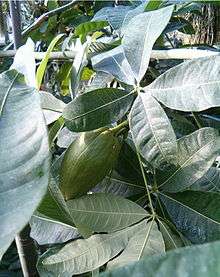Pachira glabra
Pachira glabra (syn. Bombacopsis glabra[1][2]) is a tropical wetland tree in the mallow family Malvaceae, native to eastern Brazil,[3] where it grows along rivers and other waterways.[2] It is generally known by the nonscientific names Guinea peanut,[3][2] French peanut,[2] Saba nut,[4] money tree,[2] and lucky tree.[2] It shares many of these common names with Pachira aquatica, the Malabar chestnut, which is quite similar looking, has similar culinary and ornamental uses, and is often confused with P. glabra.
| Pachira glabra | |
|---|---|
_(14089085770).jpg) | |
| Scientific classification | |
| Kingdom: | Plantae |
| Clade: | Tracheophytes |
| Clade: | Angiosperms |
| Clade: | Eudicots |
| Clade: | Rosids |
| Order: | Malvales |
| Family: | Malvaceae |
| Genus: | Pachira |
| Species: | P. glabra |
| Binomial name | |
| Pachira glabra Pasq. | |
| Synonyms | |
Description
_(14295858313).jpg)

Pachira glabra reaches heights of 9–18 meters (30–60 ft),[2] and its leaves are compound with a fan of 5 to 9 leaflets.[2] It has smooth greenish-gray bark and the trunks are often swollen at the base,[2] even at a young age.[5] Its large, white, fragrant flowers bloom on a long, terminal peduncle,[2] opening at night and dropping by the middle of the following day.[5] Its 10–20-centimeter-long (4–8 in) smooth green fruit split open naturally to reveal 10 to 25 irregularly rounded brown seeds that are roughly 2.5 centimeters (1 in) in diameter.[2]
Habitat
The tree is highly adaptable to various soils and flourishes in full sun or partial shade.[2][4] The tree is both drought and flood resistant.[2][4]
Uses
As food
P. glabra is grown in West and Central Africa as a foodcrop. The seeds are rich in oil and contain 16% protein and 40–50% fat.[3] The seeds taste similar to peanuts[3] and are typically boiled or roasted,[4] with the roasted seeds sometimes ground to make a hot drink.[3] The young leaves and flowers are also edible.[3]
As an ornamental plant
Young P. glabra trees can easily be grown in flowerpots and survive a range of conditions as long as they remain above freezing temperatures.[3] They are marketed commercially as ornamentals with several small trees in a single flowerpot, their trunks braided; specimens are similar in appearance to P. aquatica and many small ornamentals sold as P. aquatica are actually P. glabra.[5][nb 1] However, P. aquatica has woody gray bark, while P. glabra's is a smoother greenish-gray,[2] and P. aquatica will only develop a swollen trunk with age.[5] Likewise, the flowers of P. aquatica feature red-tipped petals and red anthers,[2] whereas the flowers of P. glabra are all white.[2][5] In addition, the P. aquatica blooms last marginally longer during than those of P. glabra.[5] P. glabra seeds are green rather than brown and half the size of those of P. aquatica. Seed yields are also lower than those of P. aquatica.[2]
Notes
- Even in Taiwan, where commercial ornamental cultivation of the "Malabar chestnut" (馬拉巴栗) began, the plants are usually P. glabra rather than P. aquatica.[6]
References
- "Pachira glabra Pasq." at the Plant List. Retrieved 10 May 2020.
- Odilo Duarte and Robert E. Paull. "Pachira aquatica/Malabar chestnut Pachira insignis/wild chestnut." The Encyclopedia of Fruit and Nuts. Jules Janick and Robert E. Paull, eds. CABI, 2008. p. 183. ISBN 9780851996387
- "Pachira glabra Pasq." at Plant Biodiversity Conservatory and Research Core of University of Connecticut. Retrieved 10 May 2020.
- "Pachira glabra - Pasq." at Plants For A Future. Retrieved 10 May 2020.
- Edible Plants at Hawaiian Tropical Plant Nursery. Retrieved 10 May 2020.
- 馬拉巴栗 at HK Tree.com. Retrieved 10 May 2020. (in Chinese)
External links
| Wikimedia Commons has media related to Pachira glabra. |
| Wikispecies has information related to Pachira glabra |
- Money Tree Plant – Pachira glabra: Distinguishing Pachira glabra and Pachira aquatica
- Photographs of Pachira glabra and P. aquatica flowers